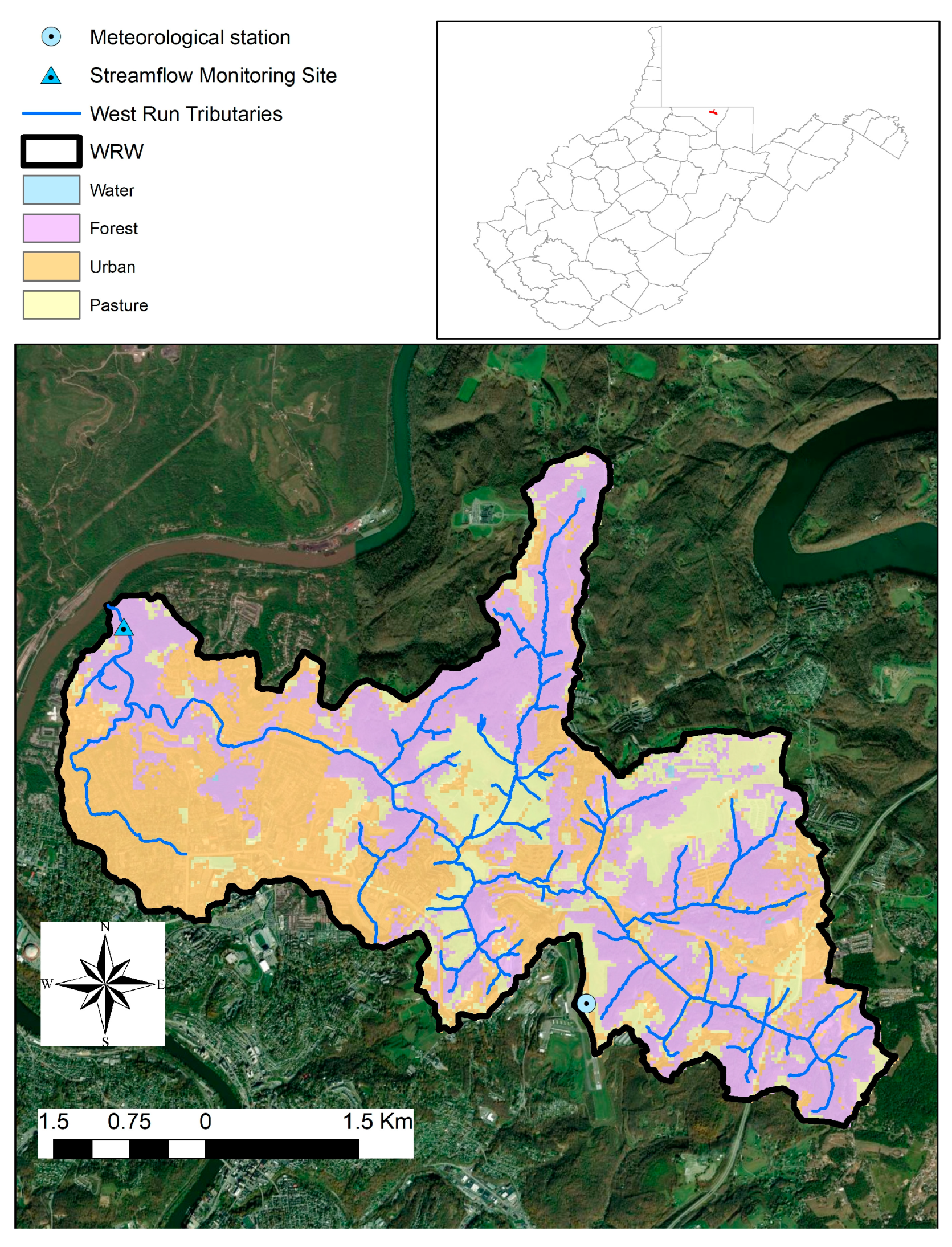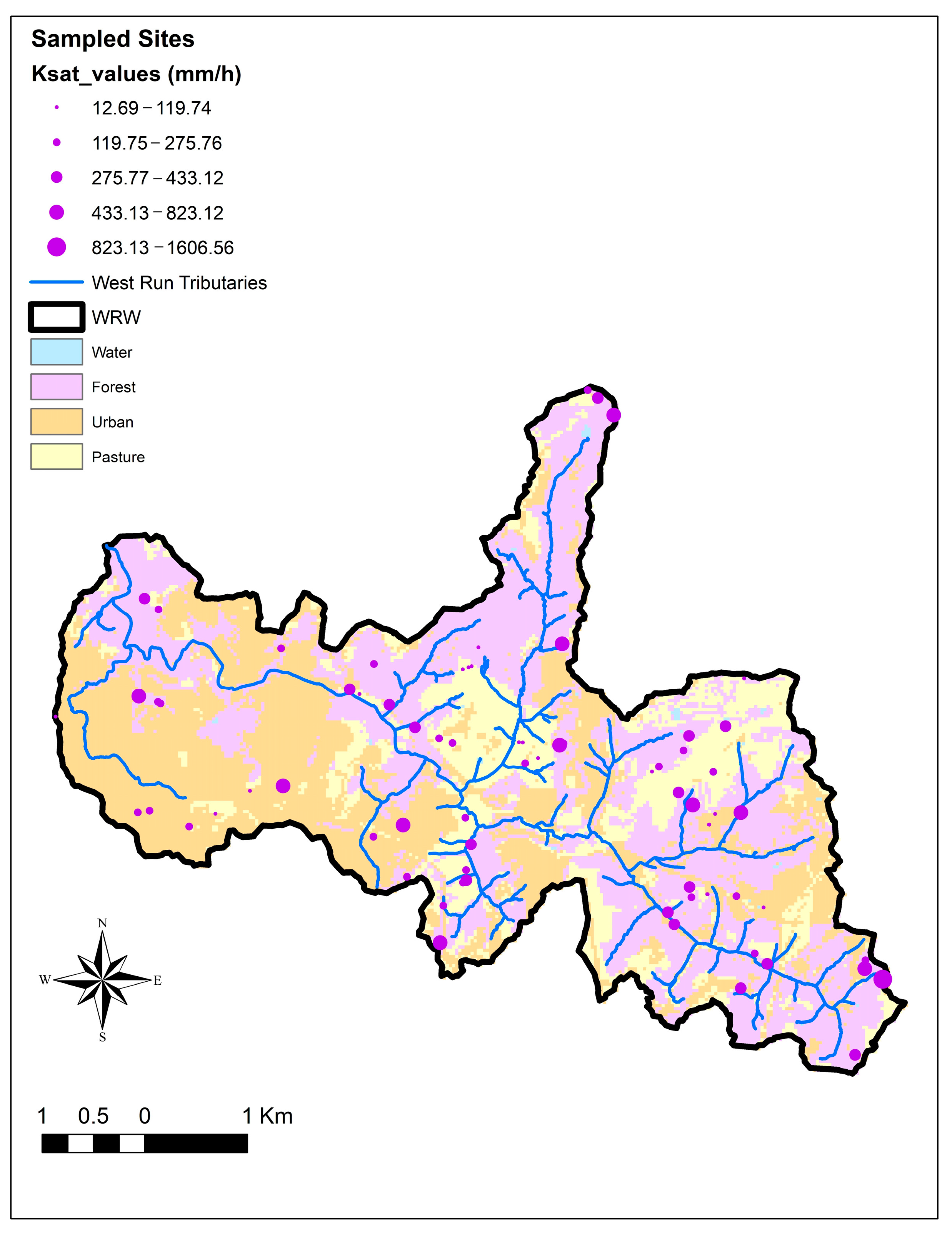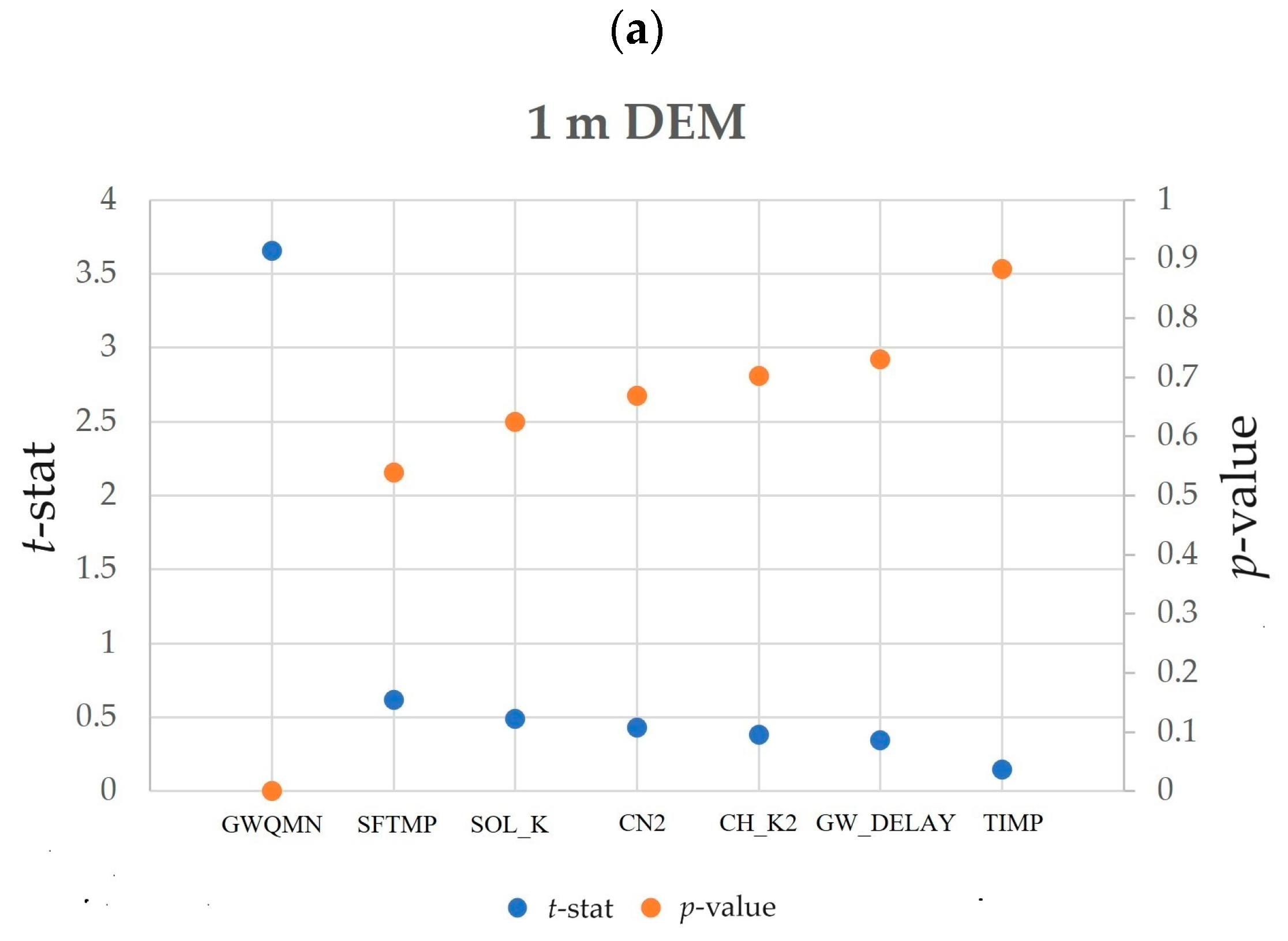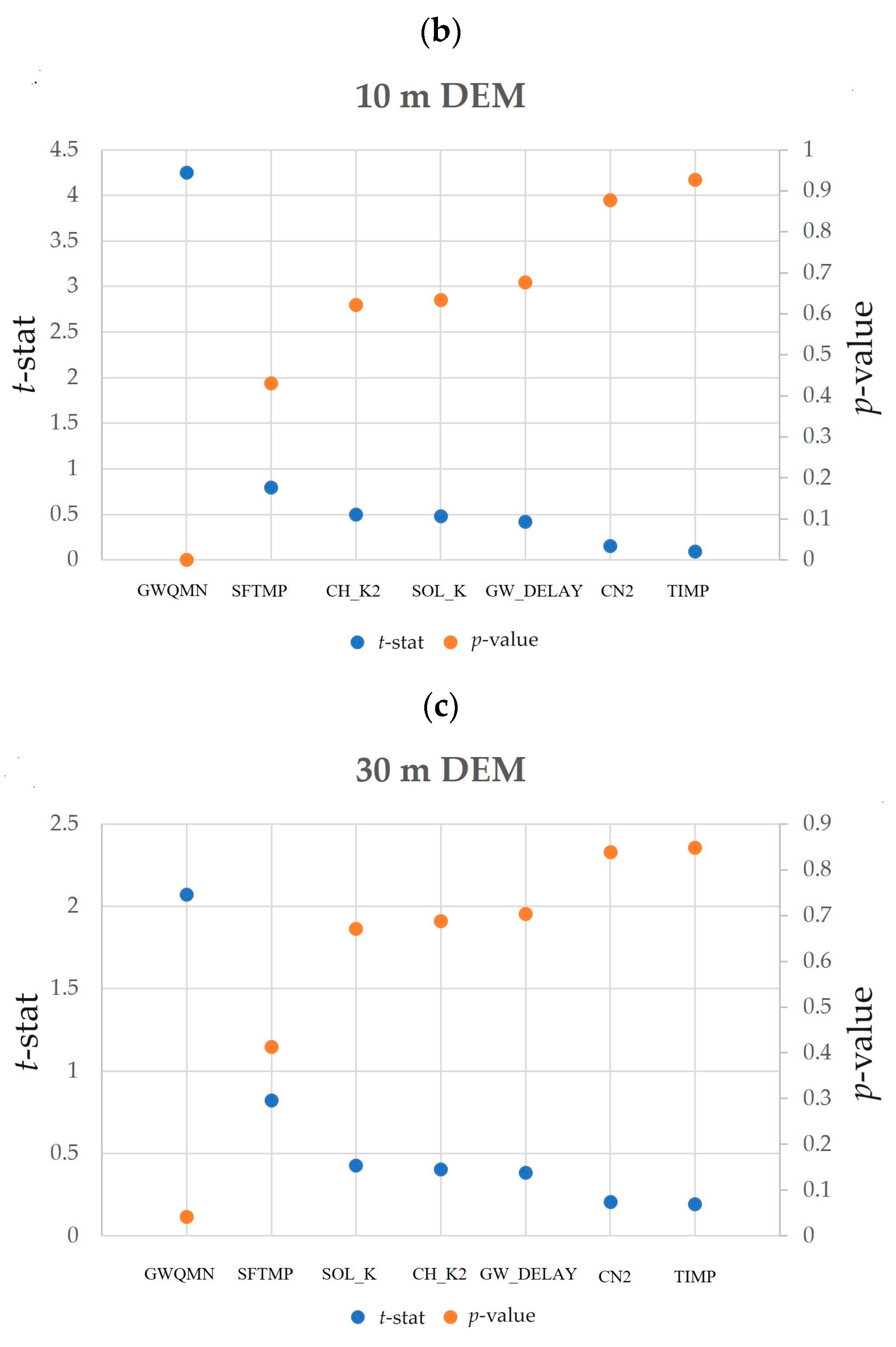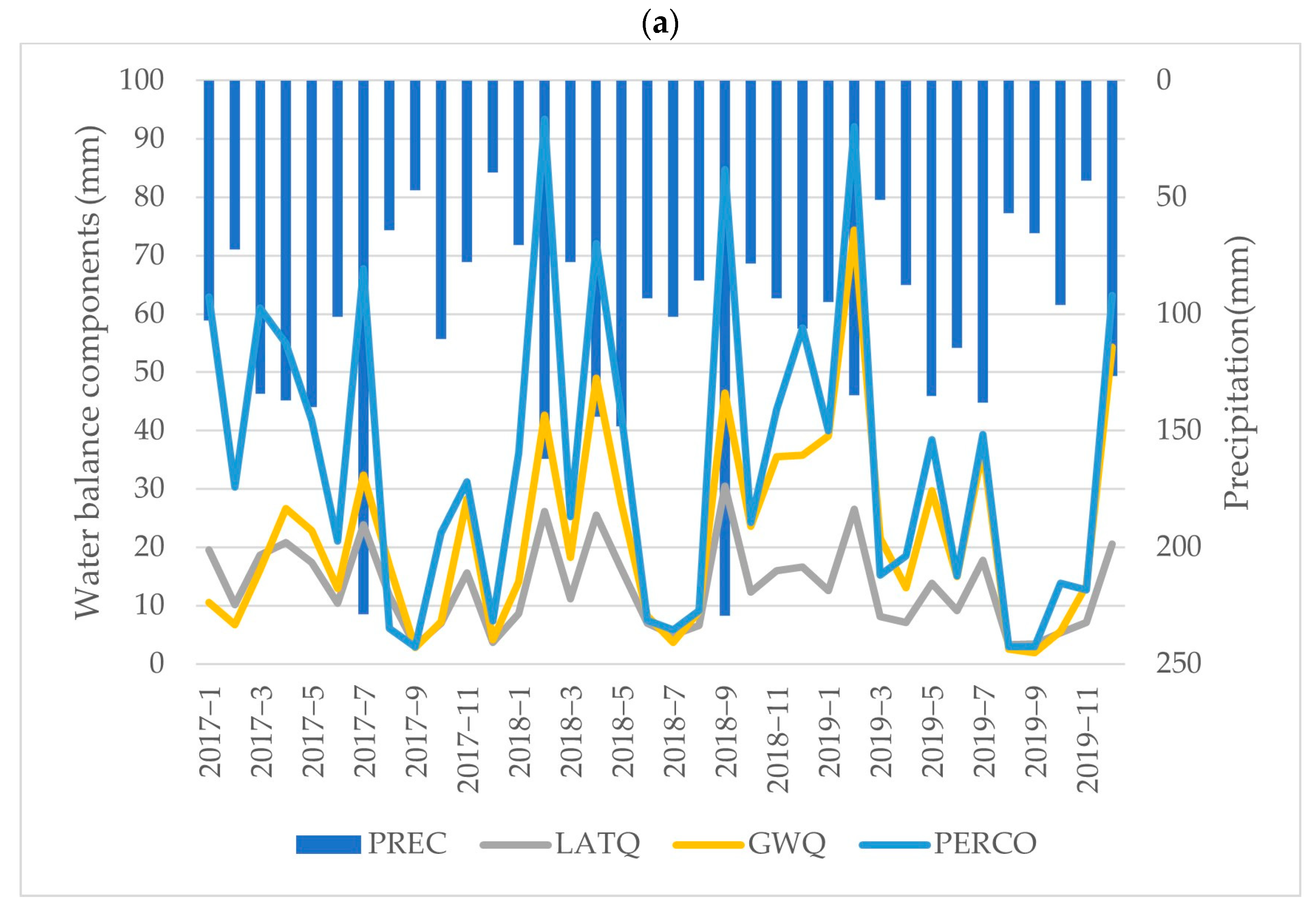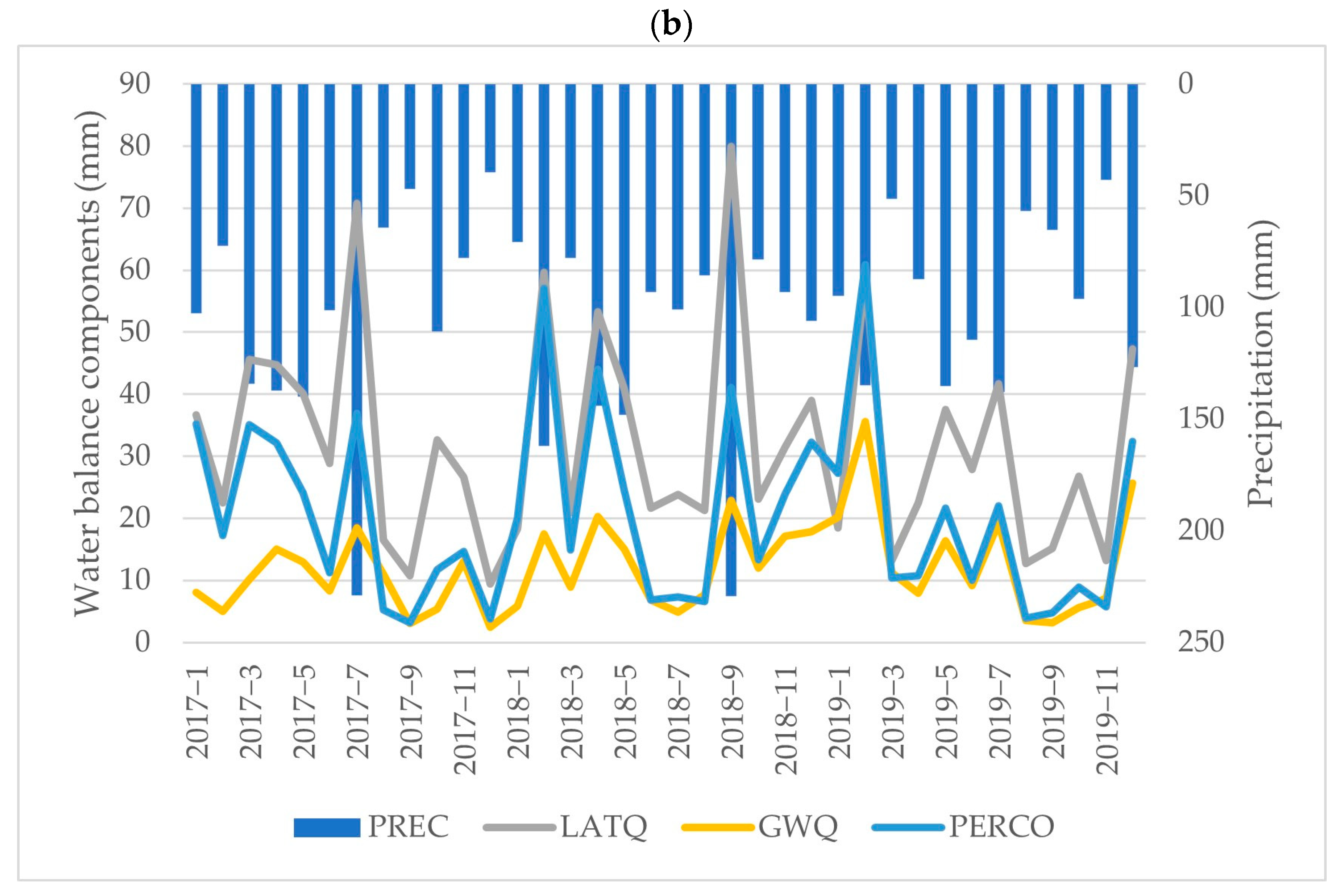3.2. Sensitivity Analysis and Model Performance Evaluation
The SWAT-CUP program with the SUFI-2 algorithm was applied in the sensitivity analysis, calibration, and validation of 1 m, 10 m, and 30 m DEMs. A total of 11 parameters related to streamflow were chosen for the sensitivity analysis (
Table 2), and the first seven high-sensitivity parameters were selected for further analysis (
Table 4). The calibration results of the three scenarios showed that the Ksat from all soil layers decreased by 17.21%. The observed saturated hydraulic conductivity generally varied between 13 and 1607 mm/h in the field. The observed Ksat values were collected at soil depths from 0 to 10 cm in the field. Therefore, the calibrated Ksat of the first soil layer (SOL_K1) was replaced with observed Ksat values to implement the research purpose of the experiment, and the primary information about soils in other layers was held constant to maintain conditions. The default saturated hydraulic conductivity values for WRW soil within the SWAT interface for the first layers were 3.276, 32.4, 82.8, and 331.2 mm/h. Furthermore, three scenario calibration results indicated that the Ksat from layer 1 of the soil decreased by 17.21%, with no significant difference between the three scenarios. Thus, the calibrated Ksat values in the first soil layer were 2.71, 26.82, 68.55, and 274.2 mm/h. Notably, the observed average Ksat values for urban (234.6 mm/h) and pasture (190.14 mm/h) land use were found to be underestimated by 16.01% and 30.66% when compared to the calibrated Ksat value of 274.2 mm/h. Conversely, the forest land use observed average Ksat value (419.62 mm/h) was overestimated by 53%.
Figure 5 shows the sensitivity analysis results of parameters contributing to the streamflow in the SWAT model of the WRW for the 1 m, 10 m, and 30 m DEMs. Parameters with greater
t-stat values and lower
p-values were more sensitive, with changes resulting in a higher impact on the streamflow simulations. The shallow aquifer water threshold depth required for return flow (GWQMN) and temperature of snowfall (SFTMP) were the most sensitive parameters for the WRW, as they showed the highest
t-stat values and lowest
p-values among the seven selected parameters (
Figure 5). The comparison between the sensitivity of parameters in different DEM resolutions showed that the 1 m and 30 m DEMs shared the same first three sensitive parameters, while the 10 m DEM only shared two parameters with the 1 m and 30 m DEMs. In the sensitivity analysis of the 1 m DEM, the factors with the highest impact on the streamflow simulation were identified as the shallow aquifer water threshold depth required for return flow (GWQMN), temperature of snowfall (SFTMP), saturated hydraulic conductivity (SOL_K), SCS runoff curve (CN2), effective hydraulic conductivity for the main channel (CH_K2), groundwater delay time (GW_DELAY), and temperature lag snowpack factor (TIMP). In the sensitivity analysis of the 10 m DEM, GWQMN and SFTMP were the top two most sensitive parameters, with CH_K2 as the third, followed by SOL_K, GW_DELAY, CN2, and TIMP. In addition to the top three most sensitive parameters in the 30 m DEM sensitivity analysis, which were the same as those identified in the 1 m DEM analysis, CH_K2, GW_DEALY, CN2, and TIMP were also identified as sensitive parameters in the 30 m DEM analysis, in the same order as in the 10 m DEM analysis, except CH_K2. These results align with the findings of Nazari-Sharabian et al. [
55], who showed that specific parameters may become more or less sensitive depending on the resolution threshold above or below.
The calibration and validation performance of the model is presented in
Table 5, and
Figure 6 compares the three model simulations with observed data using monthly values. The
R2 value obtained from the three DEMs during calibration ranged from 0.75 to 0.76, indicating a good correlation between observed and simulated streamflow data. The
PBIAS values (−10.6, −11.4, and −12.8) for streamflow simulation in WRW were negative, revealing that 10.6%, 11.4%, and 12.8% of monthly streamflow in the calibration period are overestimated. During the validation period, the
R2 values for the three DEMs ranged between 0.72 and 0.73, with higher
R2 values indicating less error variance. Based on the three statistical indices (
NSE,
R2, and
PBIAS), the SWAT model performance with the three DEMs is at least satisfactory (
R2 > 0.7,
NSE > 0.55, and
PBIAS ≤ ±15%) [
63].
Given that land use and soil types remained unchanged during model simulations, any differences in watershed delineation and streamflow generation were attributed to DEM resolution differences. As anticipated, the resolution of the DEM data impacted the number of subbasins and the layout of streams. For instance, subbasins decreased from 20 to 18 when the DEM resolutions were changed from 1 m to 10 m or 30 m. Similarly, the recommended drainage areas for streams also varied with DEM resolution, being 22.77 km
2 for the 1 m DEM, 22.6 km
2 for the 10 m DEM, and 21.81 km
2 for the 30 m DEM. The 1 m DEM generated a model-delineated area closest to the actual WRW area compared with other DEMs (
Table 6). The 1 m DEM also generated more HRUs (122) than the 10 m (86) and 30 m (87) DEMs. Furthermore, the 1 m DEM generated a streamflow of 0.315 m
3/s, which was only 7.98% higher than the observed value (0.292 m
3/s) at the streamflow monitoring site in the WRW (
Figure 1). Therefore, the results generally confirm that the higher-resolution 1 m DEM produced more detailed and accurate SWAT model output than the 10 m and 30 m DEMs.
3.3. Impact of DEM Resolutions on the SWAT Model Output
According to the topographic and watershed characteristics calculated from the respective DEM resolutions, the 1 m DEM scenario showed results closer to the actual watershed conditions than the other two DEM scenarios. Therefore, the 1 m DEM scenario output was a baseline scenario to quantify the SWAT model output uncertainties.
The effect of different DEM scenarios on the SWAT model annual output is shown in
Figure 7. Surface runoff, lateral flow, groundwater flow, percolation flow, evapotranspiration (ET), and water yield are the most common interest outputs for water balance components in SWAT model studies [
71,
72,
73,
74]. Comparison of the
RDs in the modeled outputs indicated that coarser DEM resolutions (10 m and 30 m) affect the model output uncertainties. The overall uncertainty of the annual SWAT model output increased, as the absolute
RD values in
Figure 7b were higher than the absolute
RD values in
Figure 7a. The absolute
RD values indicated that DEM resolution (10 m and 30 m) had minor impacts on the surface runoff, ET, and water yield, which ranged from 0.89 to 6.75% (less than 15%). Therefore, the effect of DEM resolution was considered negligible. However, the
RD values of groundwater flow for the 30 m resolution were from 11.38% up to 23.41%, which were greater
RD values than observed for the 10 m DEM scenario. Furthermore, the 30 m DEM resolution also greatly affected the lateral flow, and its absolute
RD values were from 17.05% to 17.22%, in a pattern similar to that of the percolation flow.
Uncertainty analysis indicated that the influence of DEM resolutions on surface runoff, ET, and water yield was negligible, as the mean absolute
RD values ranged from 0.77% to 3.5%, on average less than 15%. Therefore, the uncertainty analysis for the monthly SWAT model output was focused on lateral flow, groundwater flow, and percolation flow. The effects of the 10 m DEM and 30 m DEM resolution scenarios on these three components at the monthly scale are shown in
Figure 8. The overall uncertainty increased as the resolution increased from 1 m to 30 m. The percolation and groundwater flow were overestimated within coarser DEMs (10 m and 30 m) and monthly time series. Specifically,
RD values of percolation flow ranged from 1.6% to 21.18% and from 5.34% to 23.59% in the 10 m and 30 m DEM scenarios, respectively. Groundwater flow exhibited a similar pattern, with the most significant
RD values being 21.24% and 39.98% in the 10 m and 30 m DEM scenarios, respectively. The mean
RD value of groundwater flow in the 30 m DEM resolution scenario was 20.25%, exceeding 15% on average. The absolute
RD values for the monthly lateral flow were less than 10%, indicating that the lateral flow changed little with the 10 m DEM resolution impact. Interestingly, the 30 m DEM resolution had a more significant impact on the lateral flow, with most absolute
RD values greater than 15%, and these absolute values were nearly twice as large as the absolute
RD values in the 10 m DEM resolution scenario.
3.4. Water Balance Components Analysis Based on Observed Ksat
This study’s water balance components (lateral flow, groundwater flow, percolation flow, evapotranspiration, surface runoff, and water yield) were derived from the principles outlined in the SWAT documentation [
16].
Figure 9a–c presents the total contributions of the water balance components in the WRW. The results (i.e., lateral flow, groundwater, and percolation flow) of the one-way ANOVA showed that the outputs of the calibrated model (1 m, 10 m, and 30 m) were significantly different from the outputs obtained after substituting the observed Ksat values (
p < 0.05). Furthermore, the lateral flow increased the most among these six components after the observed Ksat values were applied to the output of the calibrated model (1 m, 10 m, and 30 m scenarios). Lateral flow using observed Ksat forcings contributed more than lateral flow using the calibrated SWAT model output (478 mm, 447 mm, and 396 mm), ranging from 1113 mm to 1338 mm. Comparatively, groundwater and percolation flow exhibited decreased trends compared to the calibrated model outputs. The groundwater flow and percolation flow ranged from 370 mm to 524 mm and from 628 mm to 851 mm after the observed Ksat values were integrated into the calibrated model’s output (1 m, 10 m, and 30 m scenarios). In addition, water yield increased after observed Ksat values were applied. However, the difference was non-significant based on one-way ANOVA results (
p > 0.05). Both evapotranspiration and surface runoff slightly declined after observed Ksat values were used in model simulations. These results are similar to the work of Bauwe et al. [
75], who found that the value of Ksat affects the estimation of water balance components. For example, if Ksat is 10 mm/h or smaller, the SWAT model generates more surface runoff [
75]. Still, some water balance components exhibited insignificant differences in the model simulation. However, insignificance should not be taken to mean that these changes would not be enough to impose hydrological or aquatic ecological challenges for the WRW.
Lateral flow showed an overall increase after the calibrated Ksat values were substituted by the observed Ksat values in the model simulations, ranging from 635 mm to over 900 mm, depending on the three different DEM scenarios (
Table 7). The Ksat-F (forest land use) had the most considerable impact on the lateral flow, contributing to an average increase of 874 mm across the three model outputs, followed by Ksat-U (urban land use) (724 mm) and Ksat-P (pasture land use) (674 mm). This result is presumably due to the specific hydrological characteristics of forest areas, such as the soil with a relatively high infiltration rate due to the native forest vegetation and minimal anthropogenic disturbance [
42]. This finding is similar to the research of Neitsch et al. [
16], who showed that lateral flow becomes more significant in areas with high-hydraulic-conductivity soil in surface layers at a shallow depth. In contrast, the groundwater and percolation flows decreased after the observed Ksat values were applied in the model simulation. The Ksat-F values caused the most significant reduction in the 30 m DEM scenario, where the groundwater flow declined by 552 mm and the percolation flow declined by 751 mm. The groundwater and percolation flow showed the smallest reduction, 340 mm and 487 mm, under the Ksat-P impact in the 1 m DEM model scenario.
Additionally, the average groundwater flow decrease across the three model outputs was 489 mm for Ksat-F, 420 mm for Ksat-U, and 384 mm for Ksat-P. Similarly, the percolation flow exhibited a higher decrease than the groundwater flow, with an overall average decline of 694 mm for Ksat-F, 561 mm for Ksat-U, and 514 mm for Ksat-P. The percolation flow decline ranged from a minimum of 487 mm to a maximum of 751 mm. These results indicated that different land use types may influence groundwater flow and percolation flow patterns. Astuti et al. [
76] and Sertel et al. [
77] showed a similar impact of urbanization on percolation flow and groundwater flow. The impervious surface caused by urban expansion decreased infiltration, affecting aquifer recharge and hydrological processes.
The observed Ksat values for forest, pasture, and urban land types caused an overall increase in water yield relative to the calibrated SWAT model output in the three DEM model scenarios, but the average increase was less than the lateral flow. Furthermore, the surface runoff and evapotranspiration showed declining trends after the calibrated Ksat values were replaced with the observed Ksat values in the model simulations. The lowest average changes in the surface runoff were 39 mm with Ksat-F, 36 mm for Ksat-P, and 37 mm for Ksat-U.
Given the preceding results, scenario 1—Ksat-U (
Figure 4) was used as a reference to demonstrate the general impact of observed Ksat on the dynamics of water balance component changes over time in this study. The most significant annual precipitation (PREC) was simulated in 2018, with a total of 1390 mm, a maximum of 229 mm in September, and a minimum of 71 mm in January (
Figure 10). Conversely, 2019 had the lowest precipitation among the analyzed years (1144 mm), 112 mm less than the amount generated in 2017 (1256 mm). All variables vary temporally with rainfall patterns (
Figure 10a). In scenario 1—Ksat-U, the Ksat value associated with urban land use emerged as a factor driving an increase in lateral flow (LATQ) within the water balance components; however, this increase was at the cost of reduced groundwater (GWQ) and percolation flow. Lateral flow replaced percolation flow in terms of increasing the most when a high precipitation event occurred (
Figure 10b). This dynamic interaction between various water balance components emphasizes the relationship between soil properties, hydrological processes, and their combined impact on watershed hydrologic processes.
